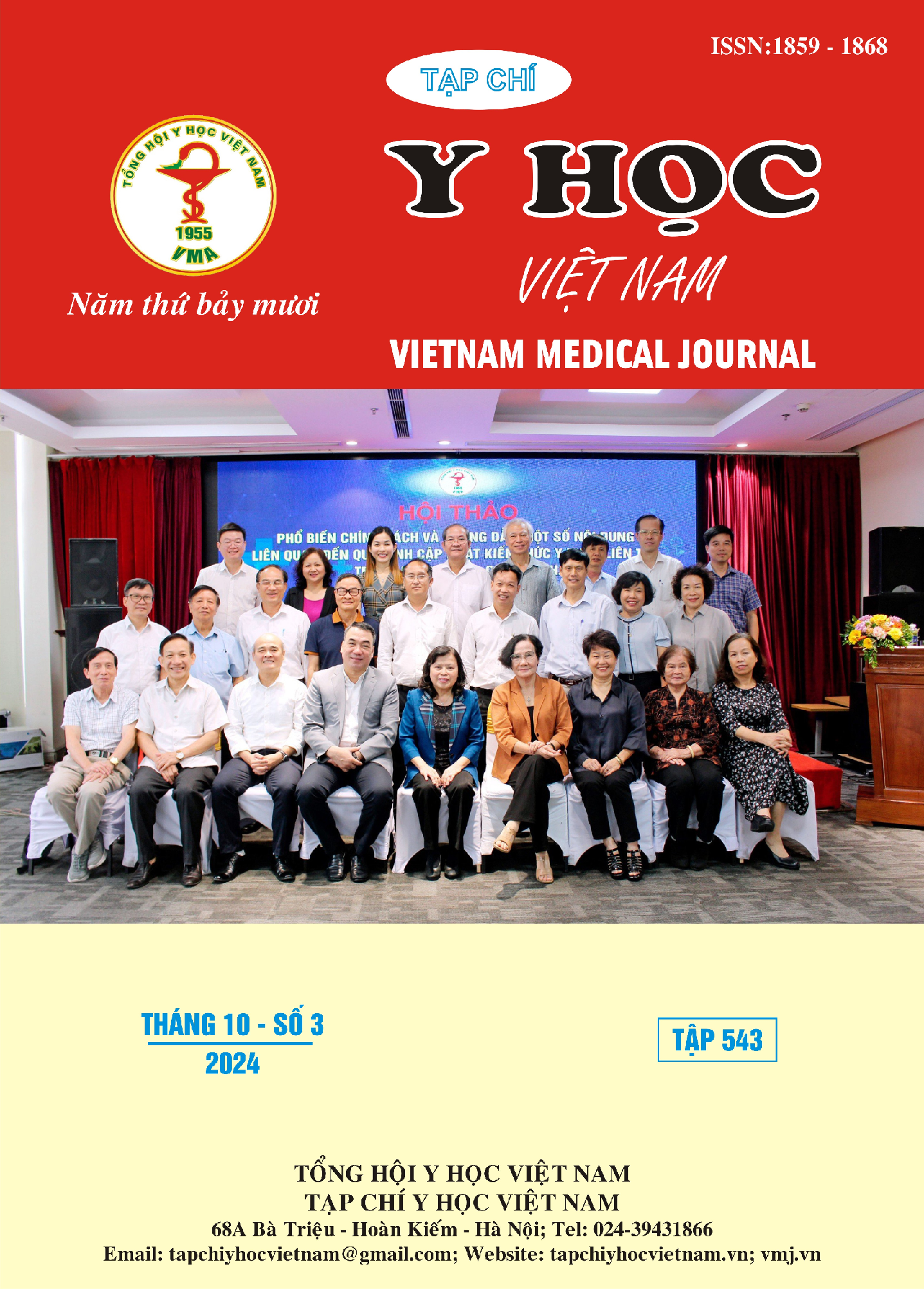THỰC TRẠNG VIÊM MŨI XOANG DO NẤM TẠI BỆNH VIỆN TAI MŨI HỌNG TRUNG ƯƠNG NĂM 2023 – 2024
Nội dung chính của bài viết
Tóm tắt
Mục tiêu: Mô tả đặc điểm lâm sàng, cận lâm sàng của nhóm bệnh nhân viêm mũi xoang do nấm được phẫu thuật nội soi mũi xoang. Đối tượng và phương pháp nghiên cứu: 86 bệnh nhân VMXDN được phẫu thuật tại Bệnh viện Tai Mũi Họng TW từ tháng 9/2023 đến tháng 6/2024. Sử dụng phương pháp nghiên cứu mô tả chùm ca bệnh. Kết quả: Các triệu chứng: chảy dịch mũi (62,8%), ngạt mũi 1 bên (46,5%), đau nhức mặt (33,7%), mất ngửi (10,5%) và hơi thở hôi (24,4%). Hình ảnh nội soi: mủ khe giữa 1 bên (83,7%), mủ ngách bướm sàng (10,5%), phù nề niêm mạc (75,6%), ngửi thấy mùi hôi (24,4%). Hình ảnh cắt lớp vi tính: điểm vôi hóa/ tăng tỉ trọng trong lòng xoang (83,7%), dày thành xương (72,1%), phá hủy các thành xương (2,3%). Tác nhân gây bệnh chủ yếu là nấm Aspergillus (95,3%), nấm Candida (3,5%), nấm Curvularia (1,2%). Giải phẫu bệnh xoang có nấm: tổ chức viêm mạn tính (81,4%), thoái hóa dạng polyp (15,1%), nấm xâm nhập niêm mạc và mạch máu (2,3%). Kết luận: viêm mũi xoang do nấm tại Bệnh viện Tai Mũi Họng Trung Ương chủ yếu do tác nhân là nấm Aspergillus, bên cạnh các triệu chứng lâm sàng phổ biến như chảy mũi, ngạt mũi, kết hợp với hình ảnh đặc trưng trên nội soi mũi xoang, chụp cắt lớp vi tính và giải phẫu bệnh sau mổ đóng vai trò quan trong việc chẩn đoán xác định và đưa ra hướng điều trị thích hợp.
Chi tiết bài viết
Từ khóa
viêm mũi xoang, viêm mũi xoang mạn tính, viêm mũi xoang do nấm.
Tài liệu tham khảo
2. Alshaikh NA, Alshiha KS, Yeak S et al (2020). Fungal Rhinosinusitic: Prevalence and spectrum in Singapore. Cureus, 12 (4).
3. Lê Minh Tâm (2008). Mối trương quan giữa lâm sàng, CT scan, giải phẫu bệnh và PCR trong viêm xoang do nấm. Luận văn tốt nghiệp nội trú, Đại học Y dược TP. Hồ Chí Minh.
4. Lê Đức Đông (2019). Nghiên cứu đặc điểm lâm sàng, cận lâm sàng và đánh giá kết quả điều trị phẫu thuật của viêm mũi xoang do nấm. Luận văn chuyên khoa cấp II, ĐHY Hà Nội.
5. K. Nomura, D. Asaka et al (2013). Sinus fungus ball in the Japanese population: Clinical and imaging characteristics of 104 cases. International journal of otolaryngology, 2013.
6. P. Grosjean, R. Weber (2007). Fungus balls of the paranasal sinuses: a review. European Archives of Oto-Rhino-Laryngology, 264 (5), 461 – 470.
7. P. Nicolai, D. Lombardi, D. Tomenzoli et al (2009). Fungal ball of the paranasal sinuses: Experience in 160 patients treated with endoscopic surgery. The Laryngoscope, 119 (11), 2275-9.
8. J.M. Klossek, E. Serrano, L. Péloquin (1997). Functional endoscopic sinus surgery and 109 mycetomas of paranasal sinuses. The laryngoscope, 107 (10, 112 – 117.
9. Seo Y-J, Kim J et al (2011). Radiologic characteristics of sinonasal fungus ball: An analysis of 119 cases. Acta Radiologica, 52 (7), 790-5.
10. Jiang R-S, Huang W-C, Liang K-L (2018). Characteristics of sinus fungus ball: A unique form of rhinosinusitis. Clinical Medicine Insights: Ear, Nose and Throat, 11, 1179550618792254.


